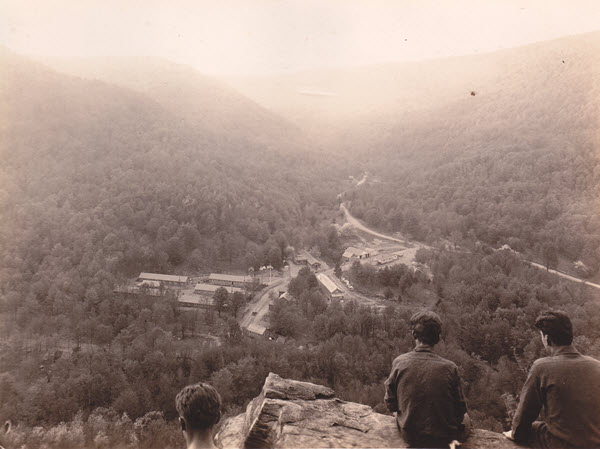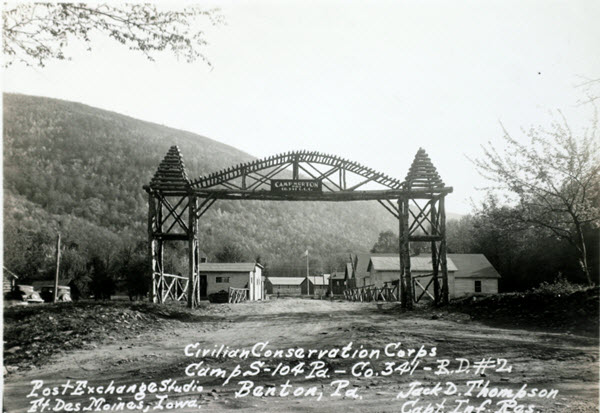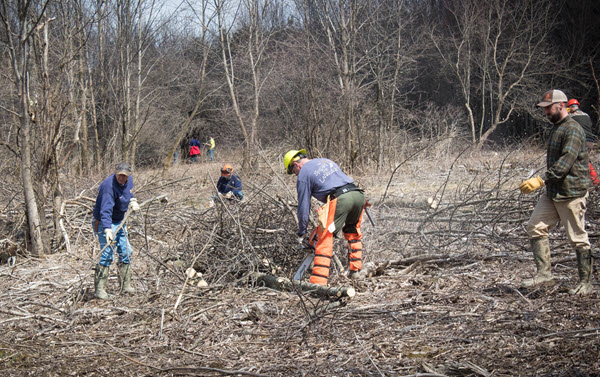Northeast Region News
| William Williams | For Immediate Release |
State Game Lands "CCC" Camp To Be Recognized With Monument
Dedication ceremony to take place at site of former Civilian Conservation Corps camp in Sullivan County
The Pennsylvania Game Commission announces an upcoming event to honor the men who served at CCC Camp S-104, known as Camp Morton, located on State Game Lands 13 in Davidson Township, southern Sullivan County. A ceremony will take place at 12 p.m. on Sunday, June 6, to include the dedication of a memorial marker at the former camp site.
The Civilian Conservation Corps was created to help combat massive unemployment while restoring the nation’s natural resources during the Great Depression and enrolled some 3 million youths nationwide. The first members of CCC Company 341 arrived at the Camp Morton site on June 6, 1933 and hundreds of men served there until the camp closed in 1937. These “CCC Boys” planted trees, built roads and dams, fought forest fires and improved wildlife habitat on this game lands. The benefits of their efforts serve the Game Commission, wildlife and Pennsylvania hunters to this day.
“Many young men who enrolled in the CCC during the 1930s went on to serve their country in World War II,” explained Game Commission Information and Education Supervisor William Williams. “It is especially poignant that this ceremony will be held on the anniversary of the D-Day invasion.”
The event will take place near the State Game Lands 13 parking lot along Elk Grove Road in Davidson Township, Sullivan County. The location is approximately 10 miles from Benton Borough in Columbia County and 1 mile north of the village of Elk Grove. This event is open to the public and will be held rain or shine.
For more information contact William Williams at the Game Commission NE Region Office at (570) 675-1143 Ext. 55008.

CCC Camp Morton enrollees sit on rock overlooking the camp in 1935.

A decorative arch greeted visitors to Camp Morton in the 1930s.
| William Williams | For Immediate Release |
Game Commission And Partners Improving Habitat
On Game Lands In Bradford County
Agency works with conservation group volunteers to benefit wildlife
The Pennsylvania Game Commission is looking for volunteers interested in participating in “habitat work days” scheduled for State Game Lands 219 in Warren Township. Habitat work will be facilitated by Game Commission employees and members of the Susquehanna Branch of the Quality Deer Management Association, Wilson F. Moore Memorial Chapter of the National Wild Turkey Federation and the NEPA Chapter of the Ruffed Grouse Society.
Habitat work will create young forest habitat used by grouse and woodcock. Activities will involve felling trees, limbing and bucking downed trees, and constructing brush piles. “The Game Commission has been partnering with these conservation organizations to improve wildlife habitat for over ten years,” said NE Region Land Management Supervisor Phil Kasper. “There are typically between five and 10 volunteers from each organization that work alongside of our wildlife habitat workers.”
Work dates are February 22 and March 7, 2020. Interested persons are asked to RSVP to the Northeast Region Office at
(570) 675-1143 to notify Philip Kasper that they plan on attending. The meeting location for each work day is the SGL 219 maintenance building located at 4835 Reagan Hill Road, Warren Center.
Volunteers should plan on being outside for the majority of the day. All volunteers must sign a liability release waiver prior to participating. Each person who is planning on felling or bucking trees is required to bring their own personal protective equipment (PPE) in addition to a chainsaw, fuel and bar oil. PPE consists of a hard hat, ear protection, protective safety glasses, gloves, saw chaps and boots.
Those interested in becoming a member of participating conservation organizations may visit their web sites for more information:
Quality Deer Management Association
https://www.qdma.com
National Wild Turkey Federation
https://www.nwtf.org/
Ruffed Grouse Society
https://ruffedgrousesociety.org/
Backcountry Hunters and Anglers
https://www.backcountryhunters.org/

Conservation volunteers creating brush-piles during a state game lands habitat work day conducted in 2019. Courtesy of PA Game Commission.
| William Williams | For Immediate Release |
Glen Onoko Falls Trail On State Game Lands 141 Closed
Hiking trail in Carbon County closed due to unsafe conditions
The Pennsylvania Game Commission announced that most of the Glen Onoko Falls Trail on State Game Lands 141 near Jim Thorpe is closed due to hazardous trail conditions. The 0.4-mile closed portion of the trail runs from the trail head to the Upper Falls.
The Game Commission cites stormwater damage, unstable surfaces and a history of accidents along the trail as factors that prompted closure. Severe injuries and fatalities have occurred over the years despite posted signs warning visitors to be cautious, wear appropriate footwear and avoid dangerous areas near the three major falls.
“Volunteer emergency personnel spend significant time rescuing people that hike the Glen Onoko Falls Trail,” said Game Commission NE Region Land Management Group Supervisor Michael Beahm. “A typical rescue for an injured hiker will involve 20 to 25 volunteer first responders and require a minimum of four to six hours.”
Heavy rainfall during the past year changed trail conditions considerably and several areas are washed out below the middle and lower falls. Sections of the trail are now unrecognizable and have become part of the stream channel. Hikers have been using alternate routes around these areas – negatively impacting soils and vegetation.
Signage and physical barriers will warn visitors of the trail closure at the Glen Onoko Falls trailhead and at other appropriate locations.
Other hiking trails in the area remain open, including the Overlook and Shortcut Trails that connect to form a 1.6-mile loop offering a panoramic view of Jim Thorpe. The Upper Falls can be accessed via Overlook Trail.
| William Williams | For Immediate Release |
Game Commission Partnering To Improve Grouse And Woodcock Habitat
Ruffed Grouse Society and energy development companies providing support in Bradford County
Good things come in threes. The third and final phase of the “Roughneck Aspen Management Project” was recently completed on State Game Lands 12 and 36 in Franklin Township, Bradford County.
Encompassing 107 acres and split into three different blocks, the project will increase the amount of “early successional habitat” acreage on state game lands. Early successional habitat is generally described as a forest in the first 20 years of growth. It serves to meet the needs of wildlife requiring young forests to flourish. Species dependent on this habitat include ruffed grouse, American woodcock, golden-winged warbler, deer, bear and turkey.
The Game Commission and the Ruffed Grouse Society partnered with three energy development companies to plan and execute the project with little to no cost to sportsmen.
Aspen stands were harvested to promote aspen root sprouting and select seed trees were left behind to provide soft and hard mast. Stems were left on site to provide cover for birds and mammals. Trees were cut during the winter months to protect root systems and ensure stored carbohydrates are at their peak for the ensuing growing season.
The project was a cooperative effort between the Game Commission, Ruffed Grouse Society, Chief Oil and Gas LLC., Energy Transfer Partners and Williams Midstream. Game Commission personnel provided technical support and oversight for the project, while the energy development companies employed contractors and provided funds to harvest timber.
Game Commission Northeast Region Forester Chad Barclay is credited with developing the project and supervised all phases of operations.
“These energy development companies have interests on state game lands and are committed to giving something back to wildlife and sportsmen,” said Game Commission Land Management Group Supervisor Phil Kasper. “The Roughneck Aspen Management Project is a prime example of how a wildlife agency, partnering with conservation organizations and industry, can make large-scale impacts on wildlife habitat within the commonwealth.”
| William Williams | For Immediate Release |
Game Commission Recognizes Trapper Instructor
Barry Warner receives award for outstanding service to agency and PA trappers
The Northeast region of the Pennsylvania Game Commission (PGC) recently awarded Dallas resident Barry Warner with an Outstanding Hunter-Trapper Education Instructor award for his contributions to the agency’s Successful Furtaker and Cable Restraint certification programs.
Mr. Warner logged over 240 volunteer hours since becoming an instructor in 2008 and donated 27 hours teaching advanced Game Commission trapping classes in 2018. He provides trapper training to cadets attending the Game Commission’s Ross Leffler School of Conservation in Harrisburg and State Game Wardens stationed in the Northeast region.
“Barry is a highly passionate, knowledgeable and skilled trapper,” said Game Commission Information and Education Supervisor William Williams. “His instruction at trapper training classes is very hands-on and he sets up a demonstration area that provides valuable visual aids, driving home key teaching points on legal and illegal sets.”
Warner also instructs at numerous Pennsylvania Trappers Association (PTA) training schools held around the state each year. He is the PTA’s public relations director and has been instrumental in developing Best Management Practices for North American furbearers.
| William Williams | For Immediate Release |
The Fisher Can't Shake its Bad Reputation
Reports of fishers wreaking havoc on game populations occasionally circulate among hunters and trappers, according to the Pennsylvania Game Commission. This predatory furbearer has been blamed for decimating turkey populations, reviled for gleefully dining on spotted fawns, and despised for its perceived unquenchable thirst for hot blood. The number of colorful metaphors used to describe them is endless – and very few are flattering.
However, when this furbearer is examined without emotional bias, what emerges is a fascinating animal deserving of a little more understanding.
The name fisher offers no description of the animal itself. Known as fisher cat, fisher weasel, and even tree otter, the secretive predator is saddled with an identity issue. It rarely eats fish and is certainly no cat.
So why the confusing moniker? The name was likely derived from a corruption of the antiquated word “fichet,” a polecat found in Europe. The common use of “fisher cat” seems to validate the theory, much to the chagrin of biologists and game wardens trying to explain its name to a confused audience.
Handsome devils?
The fisher is an omnivorous predator of the family Mustelidae - animals that are characteristically nocturnal, solitary and active year-round. Other mustelids include weasels, martens, mink, badgers and wolverines. Fishers are more closely related to the wolverine than to any of the other weasel species.
It has a well-furred long body with a full tail that makes up one third of its length. The striking coat of the fisher is mostly chocolate with legs, tail and rump a midnight black. Fur on the shoulders and head is grizzled with gold and silver, enhanced by tricolored guard hairs. The head is triangular with wide, rounded ears. A fisher’s eyes have horizontal oval pupils that produce a green eyeshine at night. Five toes on each paw sport formidable sharp, curved, semi-retractable claws. Adult males tip the scales at 7-15 pounds while females weigh significantly less.
The female usually gives birth to one to six cubs high up in a tree cavity in late March or early April. She will cycle into estrous and breed again within 10 days after giving birth, resulting in most adult females being pregnant for nearly the entire year! The pregnant fisher develops a small fertilized egg mass called a blastocyst that floats freely in the uterus. The blastocyst does not increase in size until it attaches to the wall of the placenta around 40 days prior to birth. This adaptation, known as delayed-implantation, also is seen in bears and bats. It allows young of the year to be born under the most favorable environmental conditions.
Fisher cubs weigh less than two ounces at birth with eyes closed and completely dependent on maternal care. They initially sport silver-gray fur until their coat transitions into chocolate brown at 3-4 weeks. Canine teeth erupt at 7-9 weeks and, at four months, fishers are already developing into efficient predators, attacking the head and neck region of small mammals.
Disappearing act
Ideal fisher habitat is older conifer and deciduous forests with good overhead cover and an abundance of woody vegetation on the forest floor. Their population once spread throughout Pennsylvania forests, but fisher numbers sharply declined as a result of unregulated trapping and intensive deforestation that peaked in the late 1800s. The last remnant populations were found in Clearfield, Elk, Cameron, Clinton, Potter and Sullivan counties. When fishers entirely disappeared from Pennsylvania has been lost to history.
The return of the fisher in Pennsylvania became possible when much of the state became reforested through natural succession providing suitable fisher habitat. Successful reintroduction efforts by conservation agencies in West Virginia and New York were already expanding fisher populations into the state by the mid-1990s. The Game Commission’s fisher reintroduction started in 1994 and continued for four more years releasing 190 fishers trapped in New Hampshire at six release sites throughout northern Pennsylvania.
Food for thought
A fisher is a diet generalist and opportunistic predator, taking what’s easiest to catch. The ability to forage effectively within the forest canopy and on the forest floor offers them a diversity of food options.
A fisher diet study conducted by biologists from the Indiana University of Pennsylvania and the Game Commission between 2002 and 2014, revealed some fascinating information. Ninety one fisher carcasses were collected from road-killed, incidental trapper-killed and legally harvested fishers from 30 Pennsylvania counties. Their stomach contents were rinsed, separated, dried, examined and identified. The results were eye-opening.
Mammal species were found in 83 percent, and bird species were found in 12 percent, of fisher stomachs. Fruit and seeds (12 percent), foliage (12 percent), egg shells (4 percent), reptiles, amphibians and insects (all round 1 percent) rounded out other documented food items. Rodents were the most common order of animal consumed and porcupine (a large rodent) parts were found in 11 percent of the stomachs. Fishers are considered effective porcupine predators but, as food generalists with multiple options, are not believed to greatly reduce porcupine populations.
White-tailed deer was found in 13 percent of the samples. Fishers preying on fawns has been documented, but is considered a rare event. Scavenging road-killed deer, and entrails left in the woods during hunting seasons, (most fishers for this study were collected in the fall and winter) likely account for this finding. Despite the fisher’s notoriety for slaughtering wild turkeys, not a trace of turkey parts turned up in the study samples. Fisher predation on adult turkeys and turkey poults is likely minor.
Population dynamics
The oddest finding of the diet study was that 12 percent of fisher stomachs contained the remains of other fishers, including hair, feet, claws, flesh and bone. Such cannibalistic behavior among fishers hadn’t been reported in scientific literature.
The majority of fisher stomachs containing fisher remains were from adults collected between November and February, a period of fisher dispersal. Fishers defending their territories might play a role in cannibalism and this behavior might reflect increasing population densities within a geographical area.
Because they are secretive and occur at low population densities, determining a reliable estimate of Pennsylvania’s current fisher population is difficult. However, Game Commission biologists use a number of techniques to monitor changes in fisher distribution and relative abundance. Techniques include monitoring the number of fishers sightings reported to game wardens, incidental captures by trappers, roadkill data, and fishers harvested during the trapping season.
The Game Commission created a fisher trapping season in 2011 and the harvest limit has been one fisher per trapper each year since. Furtakers harvested 126 fishers in that initial year. The 2018 fisher trapping season that ran from Dec. 15-26 saw a record high of 503 fishers taken in 15 of 23 Pennsylvania wildlife management units.
“Fishers continue to expand numerically and geographically in Pennsylvania,” said Game Commission Furbearer Management Section Chief Matt Lovallo. “It was once thought that they required large tracts of unbroken forests to thrive. However, they can now be found everywhere from big woods to small suburban woodlots.”
The Game Commission’s 10-year fisher management plan is due to be updated in the near future. Lovallo expects there will be some changes contained in the plan that will provide sportsmen with more opportunities to take fishers.
Evil, mean, and nasty?
Projecting human characteristics upon wild animals is unfortunate and unreasonable. The fisher is no more evil than an owl is wise, no meaner than a fox is sly, and no nastier than a newborn fawn is adorable. Many find elements of fisher behavior boorish and their eating habits downright unpalatable. But in contemporary parlance, the fisher “is what it is” – a fascinating furbearer, diet generalist and efficient predator that has returned to resume its place among Pennsylvania’s wildlife community.
If you are lucky enough to catch a glimpse of one bounding around in Penn’s Woods, consider yourself fortunate. And if you have to choose some adjectives to describe this fascinating furbearer - try to be nice.